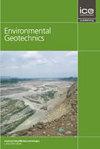Influence of Weather, Soil Variability, and Vegetation on Seasonal Ground Movement: A Field Study
IF 2.2
4区 工程技术
Q3 ENGINEERING, GEOLOGICAL
引用次数: 0
Abstract
Expansive soils change volume due to changes in moisture content, which results in ground movement. Lightweight shallow-depth structures such as pavements, residential footings, and pipelines can suffer distress as they face additional stresses from the moving ground. The soil reactivity (the ability of soil to expand or contract due to change in moisture content) and the interactions at the soil-atmosphere-vegetation boundary are two of the major contributing factors to the ground movement. The current methodology used in design to account for ground movement is based on limited field and laboratory observations. Aiming at a better understanding of the interaction at the soil-atmosphere-vegetation boundary and its correlation with ground movement, this paper presents results from a field study. The research site was located in a semi-arid climate area and consisted of moderately to highly reactive clay soils. Part of the site was vegetated with mature trees, and part was occupied by grass. The order of 10 s of mm difference was observed in the magnitude of movement across the site owing to site soil variability as well as differences in vegetation. The areas with large trees showed relatively lower ground movement over the study period compared to the area occupied by grass, which was attributed to the microclimate created by the tree canopy and the already established deeper drying of the soil near the trees.气候、土壤变异和植被对季节性地面运动的影响:野外研究
膨胀土由于含水率的变化而引起体积的变化,从而引起地面运动。轻质的浅层结构,如路面、住宅基础和管道,由于面临来自移动地面的额外压力,可能会遭受压力。土壤反应性(土壤因含水量变化而膨胀或收缩的能力)和土壤-大气-植被边界的相互作用是地面运动的两个主要影响因素。目前用于解释地面移动的设计方法是基于有限的实地和实验室观察。为了更好地理解土壤-大气-植被边界的相互作用及其与地面运动的相关性,本文给出了野外研究的结果。研究地点位于半干旱气候区,由中高活性粘土组成。场地的一部分被成熟的树木所覆盖,一部分被草所占据。由于立地土壤的变异和植被的差异,在整个立地的移动幅度存在10秒mm的数量级差异。在研究期间,与被草占据的地区相比,有大树的地区地表运动相对较低,这是由于树冠造成的小气候和树木附近土壤已经形成的较深的干燥。
本文章由计算机程序翻译,如有差异,请以英文原文为准。
求助全文
约1分钟内获得全文
求助全文
来源期刊

Environmental geotechnics
Environmental Science-Water Science and Technology
CiteScore
6.20
自引率
18.20%
发文量
53
期刊介绍:
In 21st century living, engineers and researchers need to deal with growing problems related to climate change, oil and water storage, handling, storage and disposal of toxic and hazardous wastes, remediation of contaminated sites, sustainable development and energy derived from the ground.
Environmental Geotechnics aims to disseminate knowledge and provides a fresh perspective regarding the basic concepts, theory, techniques and field applicability of innovative testing and analysis methodologies and engineering practices in geoenvironmental engineering.
The journal''s Editor in Chief is a Member of the Committee on Publication Ethics.
All relevant papers are carefully considered, vetted by a distinguished team of international experts and rapidly published. Full research papers, short communications and comprehensive review articles are published under the following broad subject categories:
geochemistry and geohydrology,
soil and rock physics, biological processes in soil, soil-atmosphere interaction,
electrical, electromagnetic and thermal characteristics of porous media,
waste management, utilization of wastes, multiphase science, landslide wasting,
soil and water conservation,
sensor development and applications,
the impact of climatic changes on geoenvironmental, geothermal/ground-source energy, carbon sequestration, oil and gas extraction techniques,
uncertainty, reliability and risk, monitoring and forensic geotechnics.
 求助内容:
求助内容: 应助结果提醒方式:
应助结果提醒方式:


